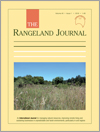RJ17057Nutrient composition and in vitro methane production of sub-tropical grass species in transitional rangeland of South Africa
Extensive livestock production systems produce most livestock-related greenhouse gas emissions and in particular methane emissions. The study investigates the influence of rangeland composition and ecological status on the nutritional quality and methanogenic potential of the rangeland. The results of the study will assist plant breeders, rangeland managers and livestock managers to select specific grass species and to develop defoliation programs that will improve livestock production in a sustainable manner.




